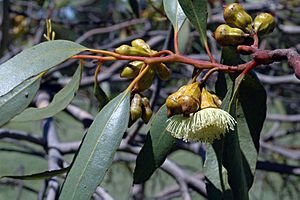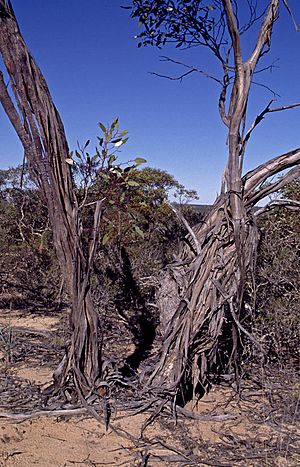Horn-capped mallee facts for kids
Quick facts for kids Horn-capped mallee |
|
|---|---|
 |
|
| Eucalyptus ceratocorys in the Waite Arboretum | |
| Scientific classification | |
| Genus: |
Eucalyptus
|
| Species: |
ceratocorys
|
The Eucalyptus ceratocorys, also known as the horn-capped mallee, is a type of mallee tree. It grows naturally in parts of South Australia and Western Australia. This plant has rough, ribbon-like bark near its base. Higher up, its bark is smooth and greyish. It has long, narrow adult leaves. Its flower buds grow in groups of seven or nine and have small ridges. The flowers are white or cream-coloured, and its fruit looks like a small cylinder.
Contents
What Does This Mallee Look Like?
The Eucalyptus ceratocorys is usually a mallee, which means it's a shrubby tree with many stems growing from the ground. It can grow from about 2 to 10 metres (6 to 33 feet) tall. It also has a special woody swelling at its base called a lignotuber. This helps it regrow after fires.
Bark and Leaves
Near the bottom of its trunks, the bark is rough and flaky. Higher up, it's shaggy and peels off in ribbons. Young plants and new shoots (called coppice regrowth) have stems that are square. Their leaves are greyish-green and egg-shaped, about 6.5 to 8.5 cm (2.6 to 3.3 inches) long and 4 to 4.5 cm (1.6 to 1.8 inches) wide.
Adult leaves are shiny green on both sides. They are shaped like a spear, measuring 6 to 15.5 cm (2.4 to 6.1 inches) long and 1.2 to 4.5 cm (0.5 to 1.8 inches) wide. These leaves grow on a stalk called a petiole, which is about 1 to 3 cm (0.4 to 1.2 inches) long.
Flowers and Fruit
The flower buds usually grow in groups of seven or nine. They are on a main stalk called a peduncle, which is 1.3 to 3 cm (0.5 to 1.2 inches) long. Each individual bud sits on a smaller stalk called a pedicel, about 3 to 6 mm (0.1 to 0.2 inches) long.
Mature buds are oval or pear-shaped. They have ridges along their sides and are 1.7 to 3 cm (0.7 to 1.2 inches) long and 0.6 to 1.1 cm (0.2 to 0.4 inches) wide. They have a beak-like cap called an operculum, which is 1 to 1.5 cm (0.4 to 0.6 inches) long.
This mallee flowers between July and December. Its flowers are usually white or cream-coloured, but sometimes they can be red. After flowering, it produces a woody, cylindrical fruit called a capsule. These fruits are 1.2 to 2 cm (0.5 to 0.8 inches) long and 0.8 to 1.6 cm (0.3 to 0.6 inches) wide. They also have ridges along their sides and sit on a pedicel about 1 to 7 mm (0.04 to 0.28 inches) long.
How It Got Its Name
The horn-capped mallee was first described in 1934 by a scientist named William Blakely. He called it Eucalyptus angulosa var. ceratocorys. He wrote about it in his book, A key to the Eucalypts.
Later, in 1988, two other scientists, Lawrie Johnson and Ken Hill, changed its classification. They decided it was different enough to be its own species, so they officially named it Eucalyptus ceratocorys.
The species name ceratocorys comes from two Ancient Greek words. Keras means "horn," and korys means "helmet." This name refers to the horn-like shape of the cap (operculum) on its flower buds.
Where Does the Horn-capped Mallee Grow?
Eucalyptus ceratocorys grows in sandy soil. You can find it in shrubland areas between Koorda and the southern edge of the Great Victoria Desert. This area is in the southern Wheatbelt and Goldfields-Esperance regions of Western Australia.
Is It Endangered?
The Western Australian Government's Department of Parks and Wildlife has looked at the horn-capped mallee. They have classified it as "not threatened." This means that currently, there are enough of these plants in the wild, and they are not at risk of disappearing.


